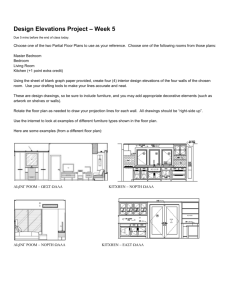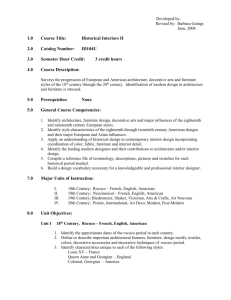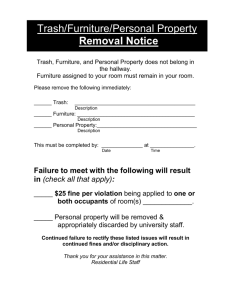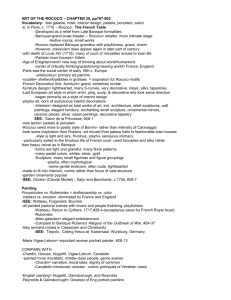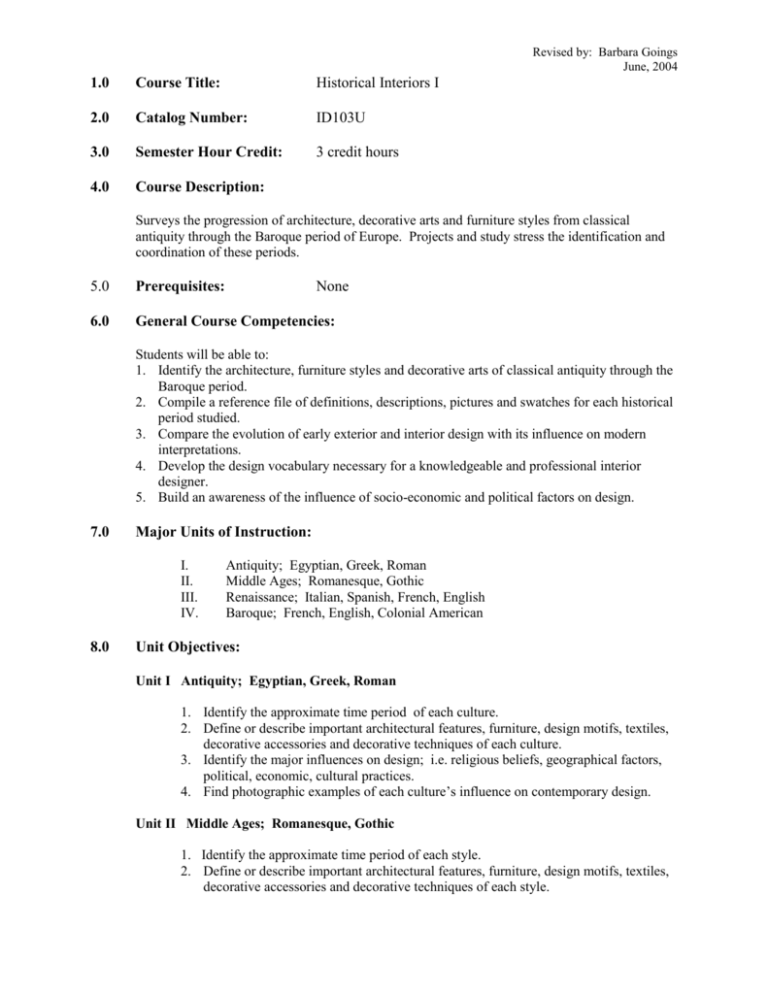
Revised by: Barbara Goings
June, 2004
1.0
Course Title:
Historical Interiors I
2.0
Catalog Number:
ID103U
3.0
Semester Hour Credit:
3 credit hours
4.0
Course Description:
Surveys the progression of architecture, decorative arts and furniture styles from classical
antiquity through the Baroque period of Europe. Projects and study stress the identification and
coordination of these periods.
5.0
Prerequisites:
None
6.0
General Course Competencies:
Students will be able to:
1. Identify the architecture, furniture styles and decorative arts of classical antiquity through the
Baroque period.
2. Compile a reference file of definitions, descriptions, pictures and swatches for each historical
period studied.
3. Compare the evolution of early exterior and interior design with its influence on modern
interpretations.
4. Develop the design vocabulary necessary for a knowledgeable and professional interior
designer.
5. Build an awareness of the influence of socio-economic and political factors on design.
7.0
Major Units of Instruction:
I.
II.
III.
IV.
8.0
Antiquity; Egyptian, Greek, Roman
Middle Ages; Romanesque, Gothic
Renaissance; Italian, Spanish, French, English
Baroque; French, English, Colonial American
Unit Objectives:
Unit I Antiquity; Egyptian, Greek, Roman
1. Identify the approximate time period of each culture.
2. Define or describe important architectural features, furniture, design motifs, textiles,
decorative accessories and decorative techniques of each culture.
3. Identify the major influences on design; i.e. religious beliefs, geographical factors,
political, economic, cultural practices.
4. Find photographic examples of each culture’s influence on contemporary design.
Unit II Middle Ages; Romanesque, Gothic
1. Identify the approximate time period of each style.
2. Define or describe important architectural features, furniture, design motifs, textiles,
decorative accessories and decorative techniques of each style.
Revised by: Barbara Goings
June, 2004
3. Identify the major influences on design; i.e. religious beliefs, geographical factors,
political, economic, cultural practices.
4. Find photographic examples of each style’s influence on contemporary design.
Unit III Renaissance; Italian, Spanish, French, English (Elizabethan)
1. Identify the approximate time period of the Renaissance in each country.
2. Define or describe important architectural features, furniture, design motifs, textiles,
decorative accessories and decorative techniques in each country.
3. Identify the major influences on design; i.e. scientific discovery, religious, political,
economic or cultural events, important people such as architects, artists, monarchs
4. Find photographic examples of each country’s influence on contemporary design.
Unit IV Baroque; French (Louis XIV), English (Jacobean, Wm. & Mary), Colonial
American
1. Identify the approximate dates of the Baroque period in each country.
2. Define or describe important architectural features, furniture, design motifs, textiles,
decorative accessories and decorative techniques in each country.
3. Identify the major influences on design; i.e. scientific discovery, political, economic,
cultural events, important people such as architects, artists, craftsmen, monarchs
4. Find photographic examples of each country’s influence on contemporary design.
9.0
Course Bibliography:
The Complete Guide to Furniture Styles, Louise Ade Boger, Waveland Press.
Designer’s Guide to Furniture Styles, Treena Crochet, Pearson Prentice Hall, 2004.
Dictionary of Furniture, Charles Boyce, Roundtable Press Inc. , 2001
Identifying American Architecture, John J. & G. Blumenson, W.W. Norton & Co., 1981.
Identifying American Furniture, Milo M. Naeve, Altamira Press, 1998.
Interior Design & Decoration, Sherrill Whiton, Stanley Abercrombie, Prentice Hall, 2002
Interiors, Karla Nielson, David Taylor, McGraw Hill, 2002.
10.0
Primary Instruction Methodologies:
Illustrated lecture
Study guides
Assignments, team in-class reviews
Field trip
11.0
Grading Criteria:
Assignments
Quizzes, Tests
90% 80% 70% 60% Below
100%
89%
79%
69%
59%
A
B
C
D
F



